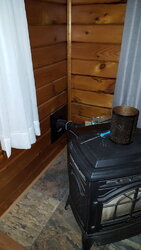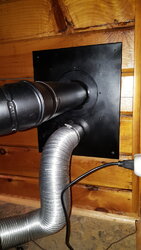I've had a QF Castile for the last 10 years and just purchased a Mt Vernon AE as a replacement. My problem is the Mt Vernon exhaust is about 3" higher than the Castile which was direct vented through the wall. I've got a couple ideas and I'm looking for some feedback.
1. Raise the existing vent to the correct height, however that's easier said than done. My house is a log cabin so patching holes isn't as easy as moving some vinyl siding around. I'll have to disassemble the vent cover to see what's in there and if I can even do this. I have the 13" cover plate, so if the inside part is 7" dia or less the plate will still cover the old hole.
2. Do a top vent on the Mt Vernon, go out the wall a few feet above the stove, and use my Castles vent as an outside air intake.
Any other ideas are appreciated.
Picture shows my current setup with the Castile.
1. Raise the existing vent to the correct height, however that's easier said than done. My house is a log cabin so patching holes isn't as easy as moving some vinyl siding around. I'll have to disassemble the vent cover to see what's in there and if I can even do this. I have the 13" cover plate, so if the inside part is 7" dia or less the plate will still cover the old hole.
2. Do a top vent on the Mt Vernon, go out the wall a few feet above the stove, and use my Castles vent as an outside air intake.
Any other ideas are appreciated.
Picture shows my current setup with the Castile.



